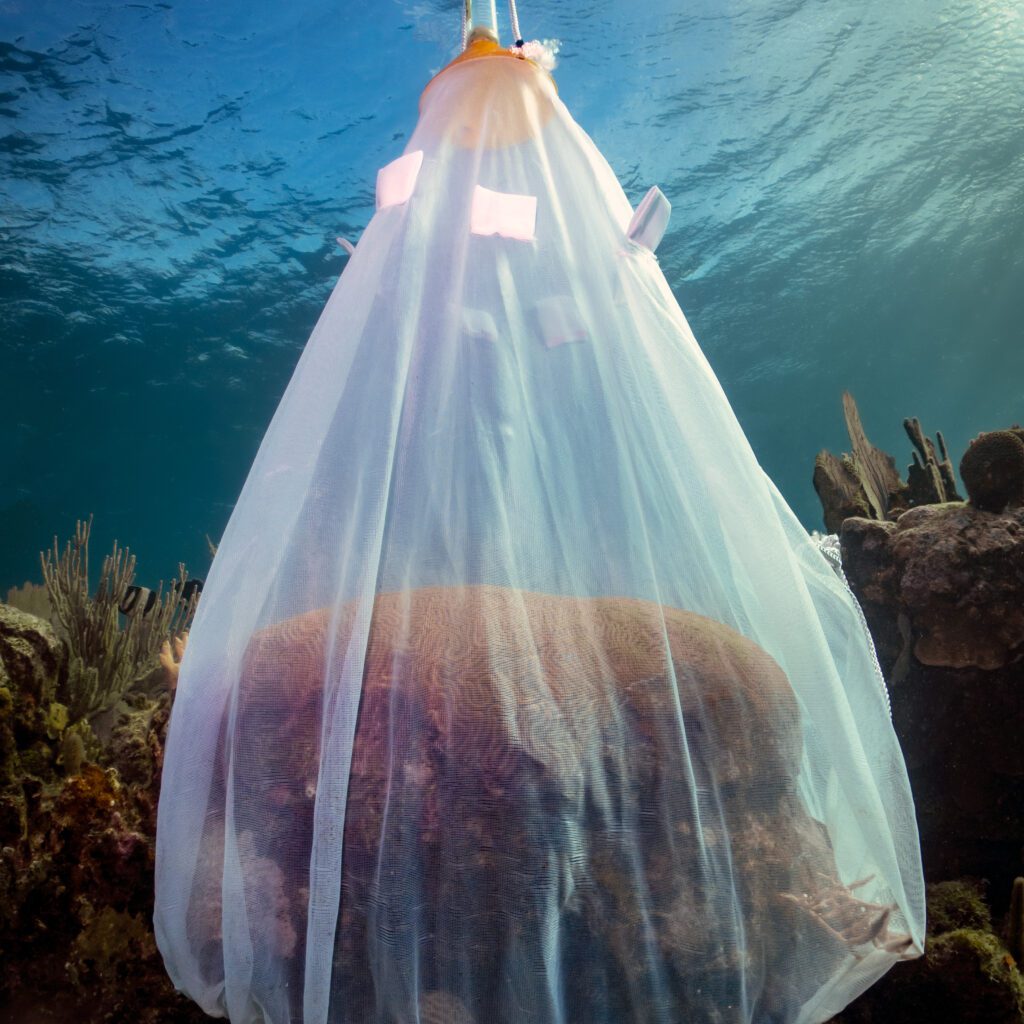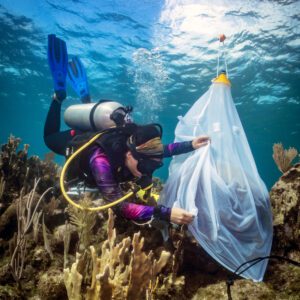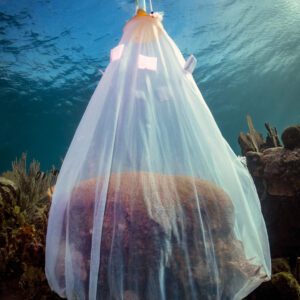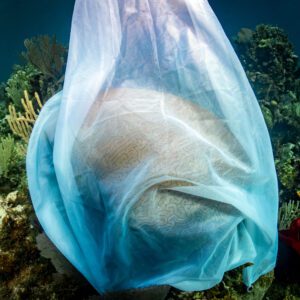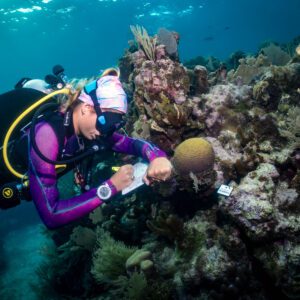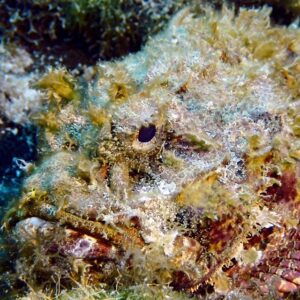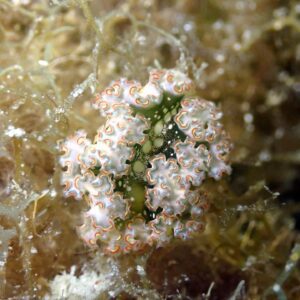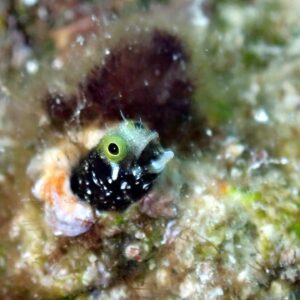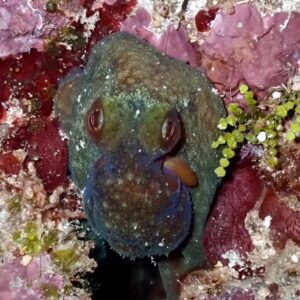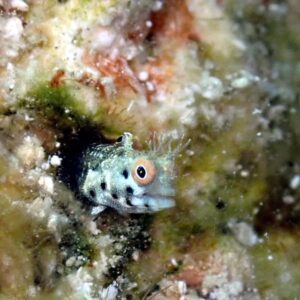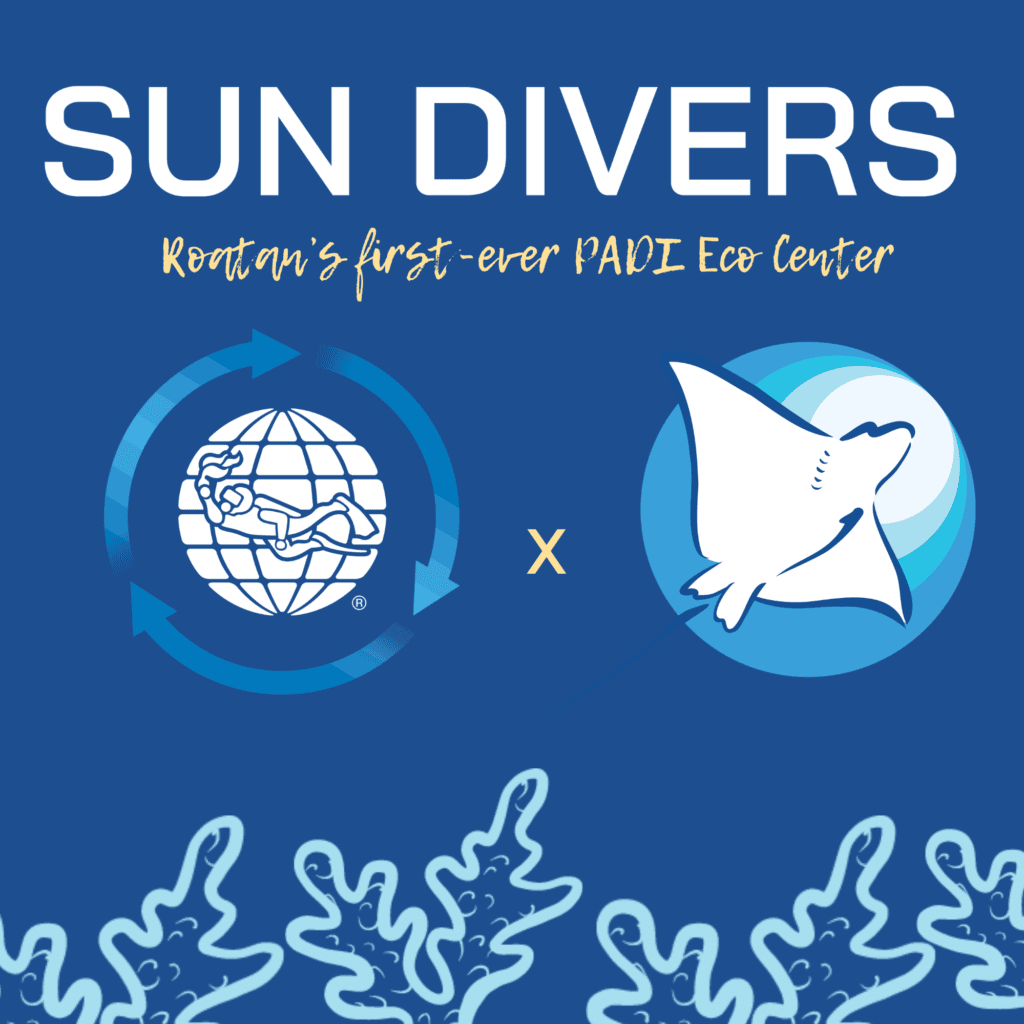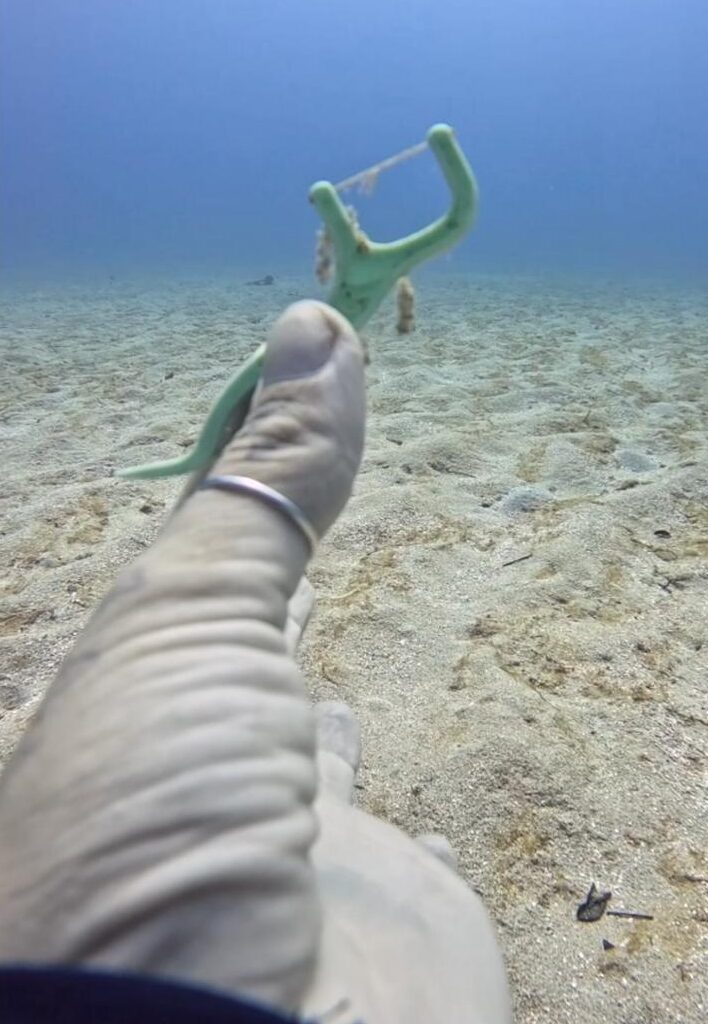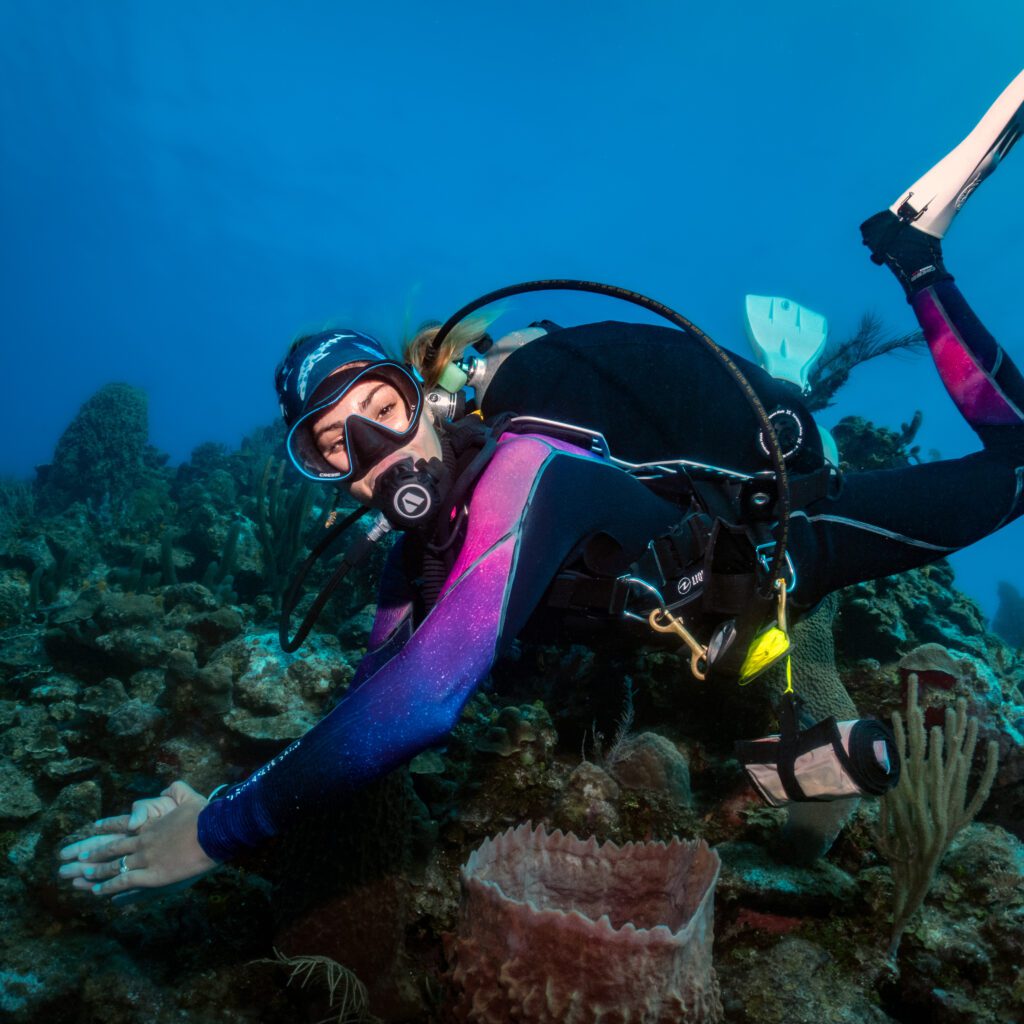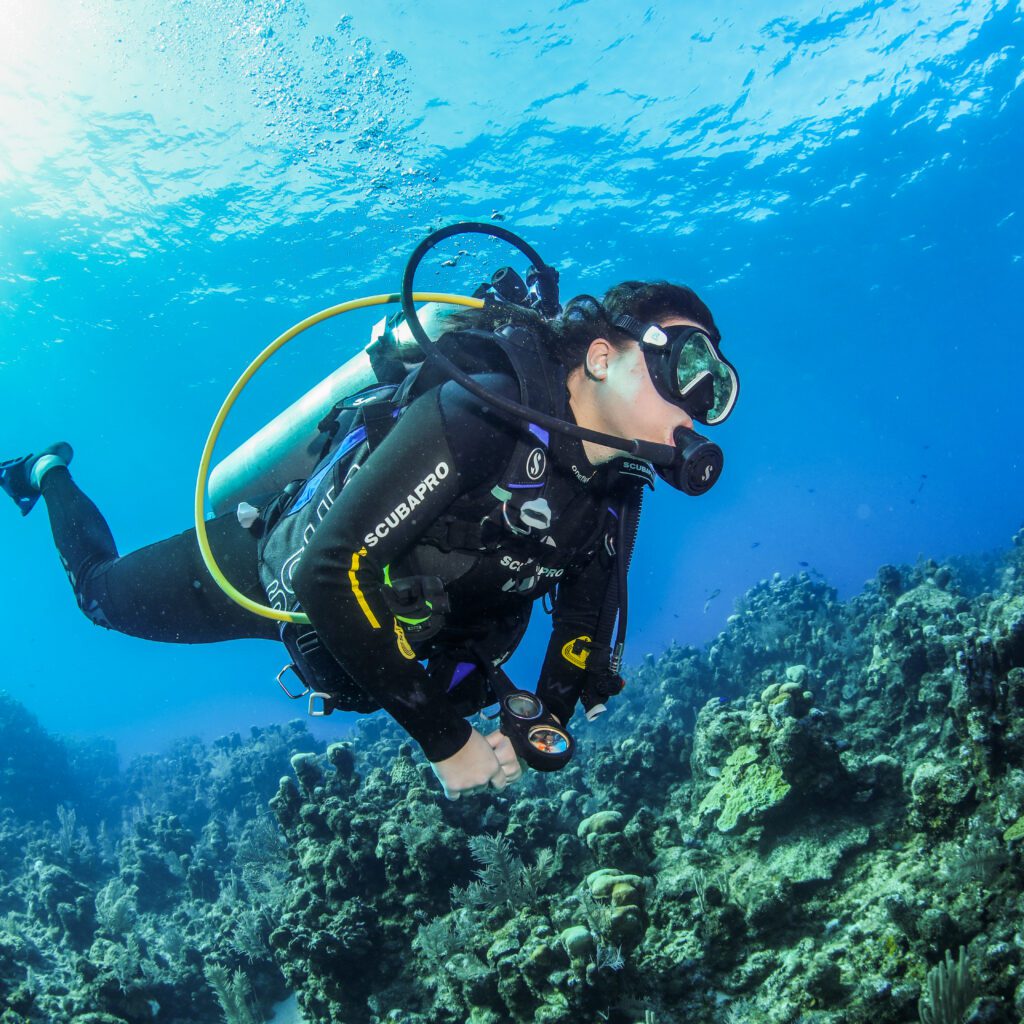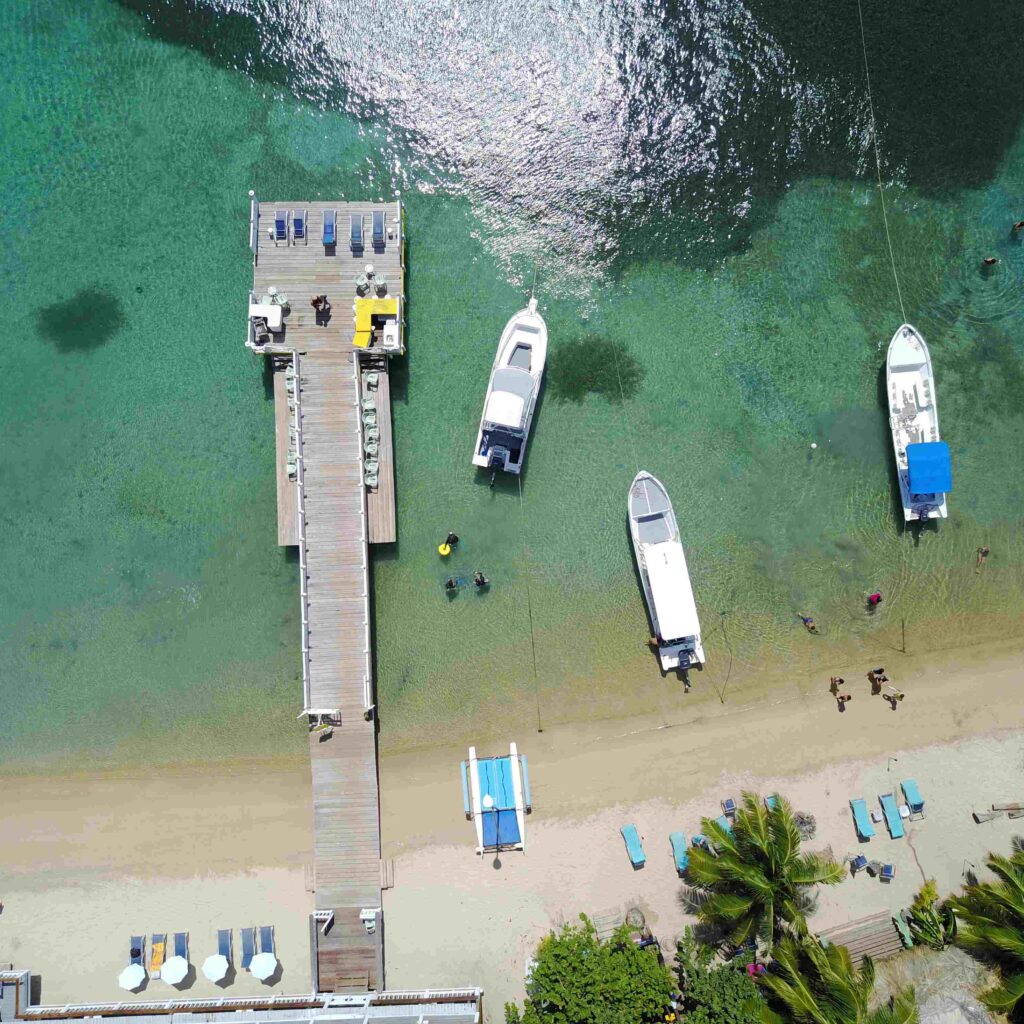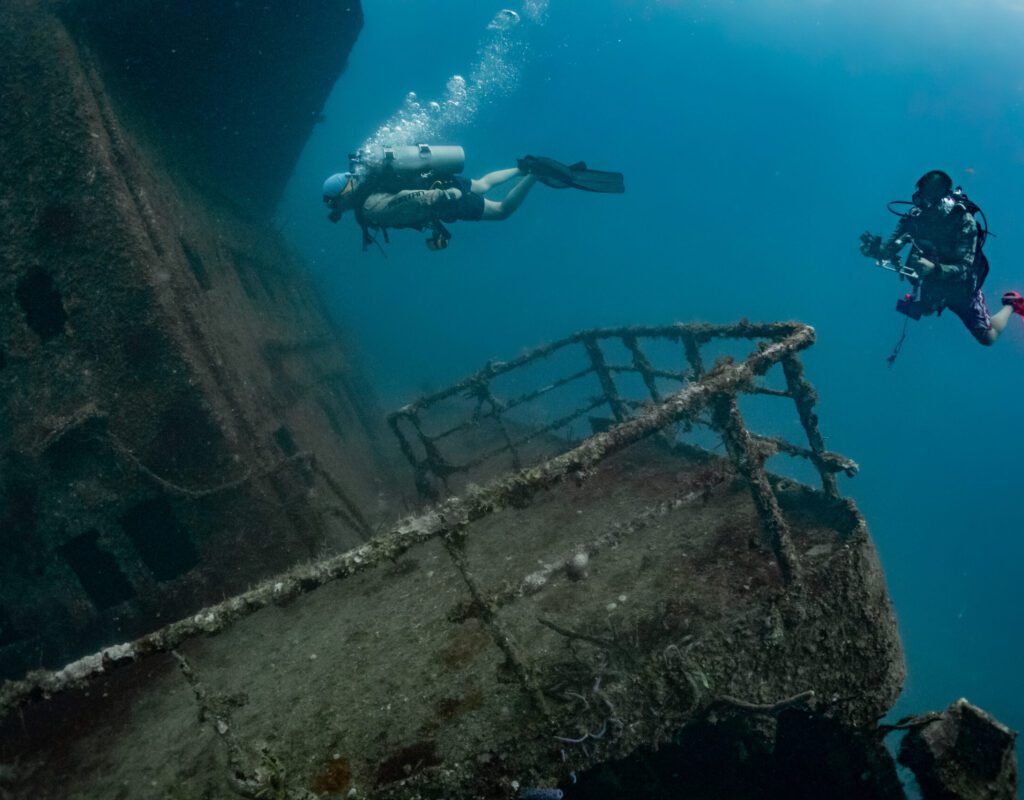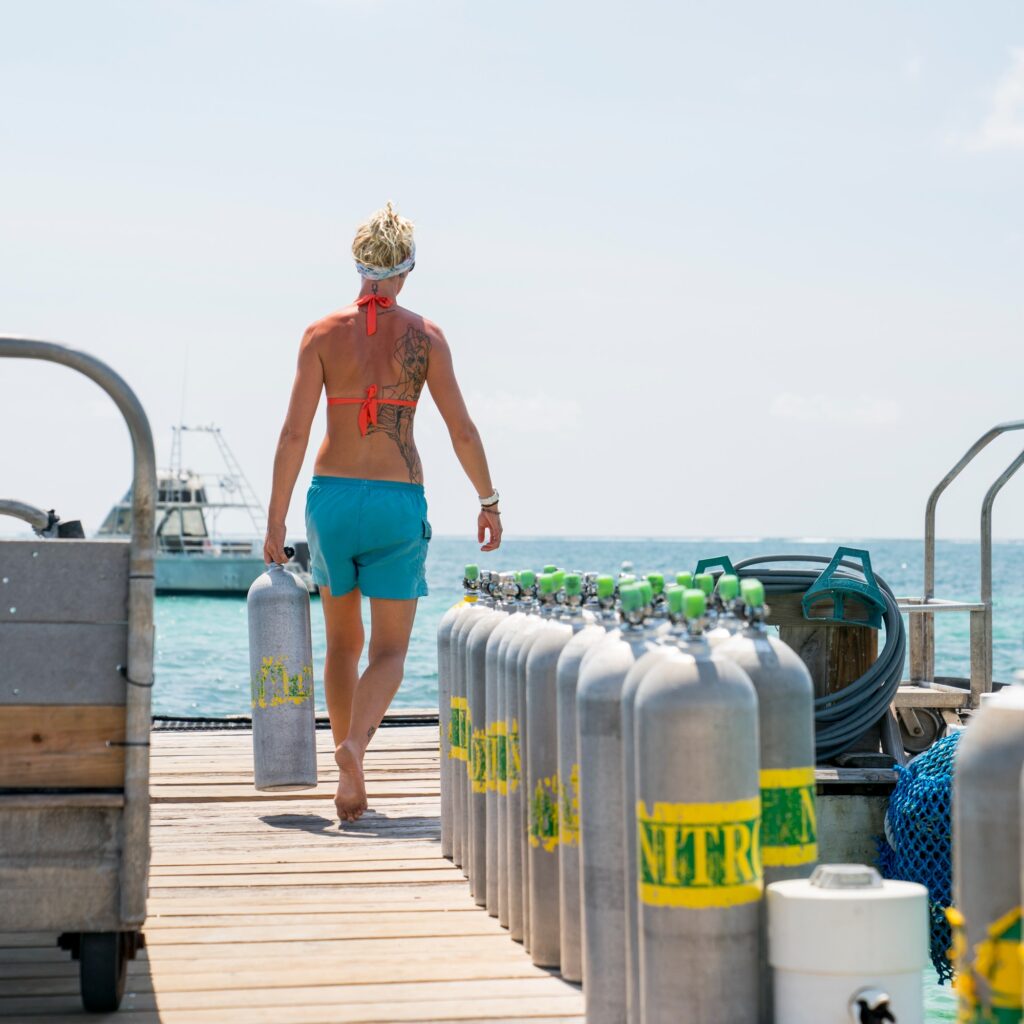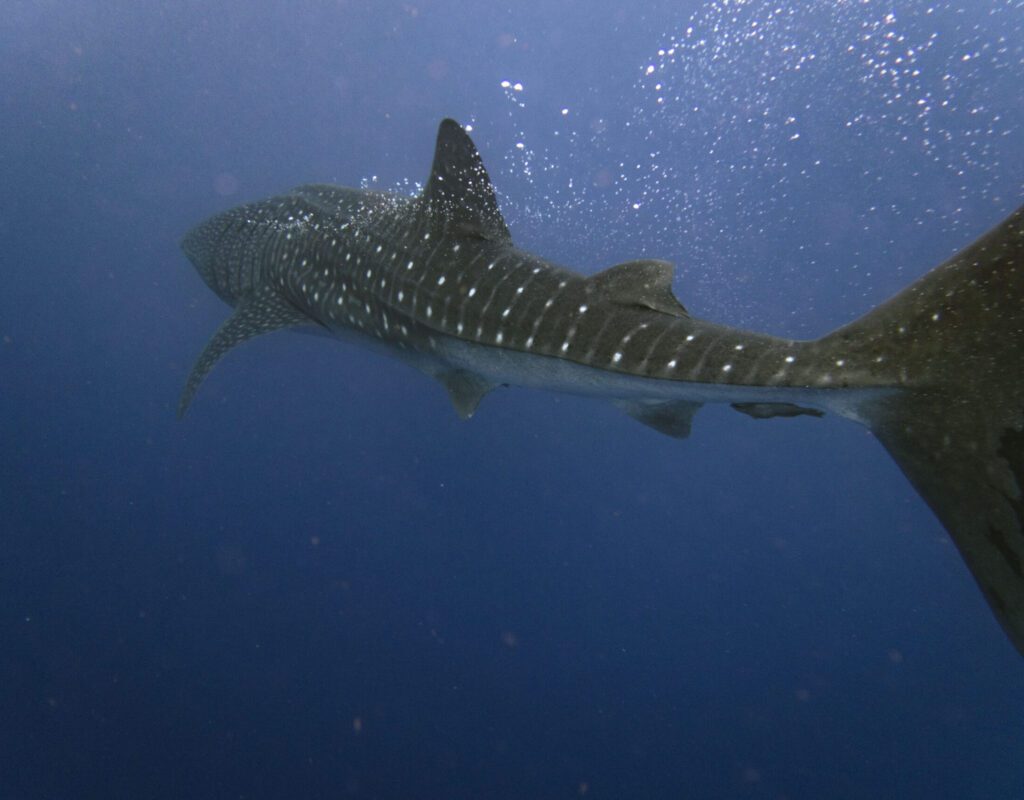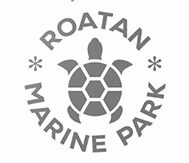Topic: Blogs
From Fun Diver to Ocean Advocate
My journey from diver to conservationist
Guest Blog By Erin Mayberry
Hi, my name is Erin Mayberry and I’ve been diving with Sun Divers in Roatan for four years now. What started as an adventurous hobby has evolved into a deeper commitment to ocean conservation, transforming me from a recreational diver seeking thrills to an active protector of marine ecosystems. My journey has consisted of small, intentional changes -both underwater and in daily life – to create meaningful impact for our oceans. Through sharing these experiences, I hope to inspire you to discover your own path toward ocean conservation – whether you’re a diver or simply someone who cares about the future of our planet.
Initial Diving Experience
In 2017, I was living in Austin, Texas when my mom called me and said, “We should get scuba certified.” I grew up visiting the beach and always found myself taking vacations to tropical islands as an adult, so it was an easy sell. My adventurous side kicked in and we booked a trip to Crystal River, FL.
For me, scuba diving started as a way to challenge myself and experience a new (to me) world beneath the ocean’s surface. Getting certified in Crystal River didn’t disappoint. My confined water sessions were spent watching a mother and baby manatee laze about their day and my first open water dives were in cenotes.
I was instantly hooked. I started booking trips specifically to dive and traveled from Hawaii to Mexico and throughout the Caribbean searching for new adventures. I was only aware of the thrill of each new dive and what might be waiting for me underwater and less aware of the environmental impact I was having on each trip.
The Turning Point to Becoming an Ocean Advocate
Then a colleague told me about his recent trip to Honduras, to a small island called Roatan with a large diving community. True to nature, I immediately booked a month-long trip to see for myself the eagle rays, turtles and pristine reefs he raved about.
I walked into Sun Divers in August 2022 and instantly felt at home. I spent a month exploring the reefs, finding a new passion for macro life (hello, manta shrimp!) and being amazed by the string of pearls on night dives that looked like Christmas lights suspended from nothing but air. I also watched as trash piled up on the beaches throughout the week from tourists visiting from cruise ships, and even locals enjoying the bay on their days off. Some of it even made its way deeper into the ocean and made appearances beside the eels, lobster, and fish making their homes in the reef.
I watched as less experienced divers brushed up against the coral with their fins, damaging it or disrupting the fish, and even had a few less than graceful dives through swim throughs myself.
Throughout the month, I kept hearing about the importance of protecting the ecosystem and in turn protecting the communities that call it home. I could tell the entire Sun Divers crew especially felt the urgency for protecting their reef. Our dive briefs often reminded us to avoid the T’s: touching, taking, teasing, and taunting. I left at the end of the month with a better understanding that there was more to diving than just exploring the diversity of each new reef.
Changing Perspective
I reflected a lot about that trip on my return to the U.S. It made me want to advocate for the marine life that couldn’t do so itself. At the same time, I started becoming more invested in sustainable choices I could make at home. I had long ago given up plastic straws, but it was the catalyst for other changes I was now making as well. Here’s a couple ways I changed my habits at home that you might consider as well:
#1 – Eating a plant-based diet: I decided to cut most meat and seafood from my diet. While I haven’t completely eliminated seafood, I limit my consumption to when I am traveling and make more informed decisions when selecting meals, only choosing to eat fish I know has been locally and sustainably caught and according to local responsible consumption guidelines.
#2 – Switching to reusables: I always carry a reusable water bottle, but I started noticing how many single-use items I was using. From paper bags for groceries to to-go cups for coffee, I made a point to start replacing these with reusable items whenever I could. I now carry reusable bags, coffee mugs, and utensils everywhere with me.
#3 – Composting: In an effort to reduce the amount of waste I produce, I started composting at home. I cook a lot when I’m not traveling, so I immediately noticed a change in how long it took me to fill a trash bag. It’s also been a bonus to my herb garden!
While I started making changes in my life on land, I also started to shift my mindset from viewing diving as just a hobby to seeing it as a way to also protect this reef I’d grown to love.
The month I spent in Honduras allowed me to get to know the community and the reefs more intimately than my past dive trips and I wanted to give back in a way that I hadn’t before.
I realized I could take a more responsible approach to diving and decided to start focusing on how I could give back to the ocean.
Evolution – Changing My Habits & Actions
Becoming an environmentally conscious diver doesn’t happen overnight. Over my last few visits to Roatan, I’ve evolved from being simply a recreational diver to becoming an active participant in coral reef conservation. From improving my diving techniques to making more sustainable choices and directly contributing to marine preservation efforts, here are three ways I’ve learned to protect the underwater world I’ve grown to love.
#1 – I improved my buoyancy & dive skills: On my second trip to Roatan, I received my PADI Advanced Open Water certification. Not only has it allowed me to explore new dive sites (visit El Aguila Wreck or Odyssey Wreck if you have the chance!) but it also helped me improve my buoyancy. Maintaining good buoyancy also allowed me to safely collect trash in crevices and on the sea floor without disrupting or harming the reef.
#2 – I stopped using petrochemical sunscreens: When I returned to the island in 2024, there was a petition to eliminate sunscreens and other self-care products with petrochemicals that disrupt coral reproduction, contribute to coral bleaching, and harm the seagrass that is a vital part of the ecosystem for the Mesoamerican reef.
After signing the petition, my own first attempt was to completely eliminate sunscreen while on the water, but that resulted in a lobster-like complexion and a quick trip back to Sun Divers for a new rash guard. I have since opted for alternatives like rash guards, hats, and sunscreens that are reef safe when diving.
#3 – I took action! One of my favorite experiences has been completing the Roatan MarinePark Coral Ambassador program with Sun Divers. The first portion of the course is classroom-based and teaches the different types of coral found locally and threats to the coral reef, then takes you through a ‘dry’ run (pun intended) for the underwater portion of training. The ocean classroom consisted of two dives – first to the coral nursery, where I learned how to clean the trees and ‘coral babies’ to protect them from disease and predators, and next to one of the dive sites where we replanted coral fragments to repopulate the reef.
This year, I completed the Roatan Marine Park Lionfish Hunting workshop. Although the lionfish  population has seen a decline in Roatan over the past few years, they are still a danger to the native fish species. The workshop teaches where to find lionfish and safe and humane practices for spearfishing. On my first dive officially licensed to hunt lionfish, I successfully speared two lionfish, one of which was large enough to take home for dinner.
population has seen a decline in Roatan over the past few years, they are still a danger to the native fish species. The workshop teaches where to find lionfish and safe and humane practices for spearfishing. On my first dive officially licensed to hunt lionfish, I successfully speared two lionfish, one of which was large enough to take home for dinner.
Since returning to Connecticut I have become an Inland Ocean Ambassador through connections I have made in Roatan. The Inland Ocean Coalition started in Colorado as a way to educate inland communities on their environmental impacts downstream and connect these communities with the ocean. With this training I plan to continue my conservation efforts in Connecticut through local river and park clean-ups, education and fundraising activities at local farms and breweries, and volunteering on projects hosted by other Inland Ocean Ambassadors.
Continuing to Inspire Change
Making this shift from recreational diver to ocean advocate has enriched my life in ways I never expected. Beyond the satisfaction of contributing to coral reef preservation, I’ve found myself part of a passionate community of divers and conservationists who share my commitment to protecting marine ecosystems. Each time I return to Roatan, I see how our collective efforts – from mindful diving practices to active conservation work – are making a real difference in preserving the underwater world that brings us together.
For those considering similar changes, know that every action matters, no matter how small. Whether you’re adjusting your diving techniques, making more sustainable choices on land, or participating in marine conservation programs, you’re joining a global community dedicated to protecting our oceans. The reef is waiting for you to become its advocate.
What will your first step be?
Contact Sun Divers Roatan for more information on how you can participate in local conservation efforts during your visit to the island.
Let’s talk about sexual coral restoration, baby!
Did you know that the Roatan Marine Park (RMP) is using some “sexy” new technology to scale up coral restoration efforts in Roatan? The local nonprofit is in its fourth year of partnering with SECORE International to bring cutting edge coral restoration to Roatan. And we’re proud to support their efforts!
Since 2022, Sun Divers customers and team members have worked with restoration leaders from RMP to monitor coral spawning activity. The 4-6 day volunteer event is conducted annually to confirm spawning times for Diploria labyrinthiformis, commonly known as grooved brain coral. When spawning occurs, it also provides the opportunity to collect the gamete (male & female germ cells) for coral breeding restoration efforts.
Read on to learn more about the fascinating phenomenon of coral spawning and how SECORE’s exciting new technology is allowing us to take advantage of this natural process to restore more of Roatan’s reefs.
So, how do corals breed?!
Corals have a gift of growing and reproducing both sexually and asexually.
Let’s talk about asexual reproduction first. When coral fragments break off from their primary colony either through natural causes or with intent for restoration, they can reattach to the reef and start a whole new colony.
Corals also reproduce sexually. This occurs through mass coral spawning events. Hard (or stony) corals release male & female germ cells called gamete all at the same time. The lucky gamete then fertilize. And, much like we learned about in junior high, they become an embryo that turns into coral larvae (also known as planula). Or if you want to keep the sex ed analogies going, you can think of these as little coral ‘babies.’ The planula can then attach to substrate and ultimately grow into a new colony.
What is coral breeding restoration?
For decades, restoration practices, including those in Roatan, have taken advantage of coral’s asexual superpowers, and “propagated” corals by cutting fragments, growing them in a coral nursery, and then outplanting them onto the reef.
While this restoration practice has a solid success rate, it is costly and time consuming. It also requires significant physical space, and manpower.
New technologies are now allowing us to lend corals a helping hand when it comes to the success rate of their sexual reproduction. Specifically in Roatan, SECORE International, a global coral restoration organization, is bringing tools, techniques and talent to help our community increase its efforts in sexual coral restoration.
Most simply, the method used by SECORE International, RMP and local volunteers like ourselves involves these five primary steps:
-
Researchers and volunteers collect data to confirm coral spawning times for keystone species.
-
Once they confirm a particular species’ spawning time and a spawning event occurs, they collect gametes. They cover the corals with a net containing a plastic vial, which captures the gametes as they float upward.
-
Researchers and volunteers then take the gametes to a land-based lab, where they cross-breed them in hopes of fertilization—think of this as IVF for corals.
-
Coral larvae attach to substrate blocks that SECORE developed, and researchers place these blocks in Coral Rearing In-Situ Basins (CRIBs) in the ocean.
-
Once the blocks develop starter colonies (recruits), they are “seeded” them onto the reef. This process requires no manual attachment, which often makes traditional outplanting time-consuming and prone to error.
The in-situ cribs only require 5% of the labor that land based facilities require, and the substrate to seeding method allows major scaling of coral coverage.
How is Sun Divers supporting?
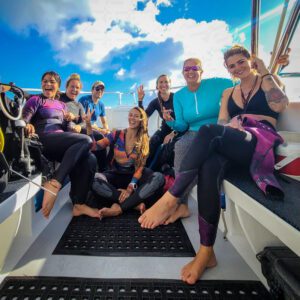
Sun Divers volunteers on their way to monitor. Photo credit: Gil Sassi
As part of our support of the Roatan Marine Park and local coral restoration efforts, every year Sun Divers contributes boats, tanks, captain time to coral spawning monitoring of Grooved Brain Coral (Diploria labyrinthiformis). Each year we monitor 15-20 colonies with around 20 volunteers. These volunteers train on how to properly net the corals and collect gamete in the event of a mass spawning event.
Every year the results are different. In 2022, the first year of spawning monitoring, only one colony spawned. And we all know it takes two to tango. So while we were able to validate the spawning calendar, we weren’t able assist in fertilization. In 2023, we had witnessed the true magic of spawning and were able to collect a significant amount of gamete to fertilize in a lab with an astounding 95% success rate – much higher than what would occur in nature. This was one of two fertilizations that had occurred resulting in 1,188 coral recruits outplanted on substrate and onto Roatan’s reefs.
Last year was a tough year for coral spawning across the world with minimal spawning occurring likely due to stress caused by the global bleaching event. But, we’re very hopeful and excited for our participation in the 2025 Spawn Watch, happening mid-June.
“Working with Roatan’s dive community to monitor coral spawning is a vital part of restoring our reef. Efforts like these wouldn’t be possible without the support of local dive shops like Sun Divers, we’re all in this together to protect the future of our ocean,” RMP Research Project Coordinator Ronald Barrera said.
What’s involved in coral spawning monitoring?
A coral spawning monitoring dive is both scientific and entertaining. It’s basically a two-hour (yes, two full hours!) dusk or night dive conducted in a small area where the majority of your focus is on 1-2 coral colonies. You’re basically waiting for that after-dark magic to happen. But while you have one eye on your colonies, you can also focus more intently than on fun dives where you have to keep moving, and watch the reef come to life.
If you love macro diving, you’ll love this because you have all the time in the world to let your eyes adjust and discover the interconnected nature of corals, gobies, blennies, crabs, shrimps, pipehorses and more. See the slideshow below for some of our cool findings on one of the dives. Larger life will also pass you by including Eagle Rays, octopus and schools of fish – the butterfly fish seem particularly inquisitive!
Okay, but back to the work at hand. While you’re monitoring, you’ll be capturing important data on an underwater slate including documenting the start & stop time of spawning should it occur.
If spawning occurs, volunteers collect gamete and that’s when the on-land cross-fertilization happens.
How can I get involved?
RMP will continue to conduct coral spawning monitoring with the hopes of kicking off a concerted coral breeding restoration program. Contact the Roatan Marine Park to participate in Spawn Watch volunteer opportunities.
We’ll also continue to offer the RMP Coral Restoration Ambassador certification to support the traditional coral nursery maintenance and outplanting. And this is a great way to volunteer when coral spawning is not occurring.
What’s next for sexual coral restoration?
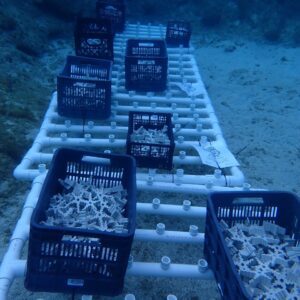
Substrates for sexual coral restoration at Overheat dive site. Photo credit: RMP
Coral spawning monitoring and gamete collection will continue into this year. If you see these substrates pictured right at sites like
Overheat, please do not touch or move them as they are part of the coral restoration efforts.
Why We Went Eco!
We’re incredibly proud to share that PADI is officially recognizing Sun Divers as Roatan’s first-ever PADI Eco Center. This achievement marks both a dream realized and a deep commitment to the reef we love. It also inspires us to look back with gratitude on the journey that brought us here and to share that story with you.
Becoming a PADI Eco Center as a Commitment to Roatan’s Future
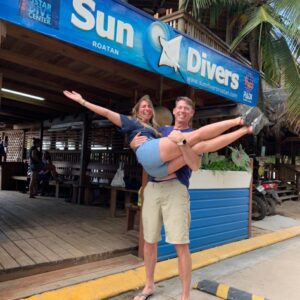
The first day of our big dream, January 2021
“A dive shop is not an NGO.” That was the response I got from my industry peers when sharing our vision of how we’d shape Sun Divers – the dive shop that my husband Shannon and I had just moved to Roatan to take ownership of. Instead of letting those words discourage, we doubled down on the belief that we could create a dive center that was as much about making waves of impact, as it was about creating epic adventures on Roatan’s reef.
We chased the dream of owning a dive shop on a little slide of paradise for years. (Read this Forbes profile on how we made it happen). We knew from the beginning we would build our dream dive shop around a core value: being always eco-active. To us, that means going beyond simply caring about ocean protection. It means that we take meaningful action, and we create opportunities for others to get involved and become part of the movement.
We began by looking inward, identifying ways to reduce our carbon footprint as a business. That meant moving to online waivers to cut paper waste and offering reef-safe sunscreen, defog, and shampoo at our facilities. From there, we partnered with the Roatan Marine Park and the Bay Islands Conservation Association—two local NGOs that co-manage the Bay Islands National Marine Park.
Our commitment continued to grow as we joined conservation advocacy groups and even launched our own scuba scholarship program with local partners Roatan Peer Health Exchange. This scuba scholarship program is designed to empower local girls to become conservation-minded divers.
Just four years after those discouraging words, we’ve watched our vision grow from a small hope into a big reality. Consequently, being named Roatan’s first-ever PADI Eco Center is a reminder that when you lead with heart, purpose, and unwavering belief, you can turn doubt into impact and dreams into something that matters.
Why Become a PADI Eco Center?
PADI Eco Center is a special designation that PADI gives to dive centers who demonstrate a high level of commitment to conservation and dive industry sustainability.
There are two core focuses of PADI Eco Centers: The first is creating opportunities for divers to participate in direct conservation. This is including citizen science, policy advocacy and education. PADI Eco Centers meet these criteria specifically by participating in the PADI AWARE’s Adopt the Blue program. Of course, we like to take it a few steps further supporting local conservation efforts as well.
The second core focus of PADI Eco Dive Centers is to embed sustainability as a core value of their business. This means acting to reduce their environmental footprint.
At Sun Divers, we knew that becoming a PADI Eco Center was the natural next step in our journey. It aligned with our mission to be more than just a dive shop—to be a hub for positive change in marine conservation. So, what does that look like in practice?
Our Commitment to Conservation
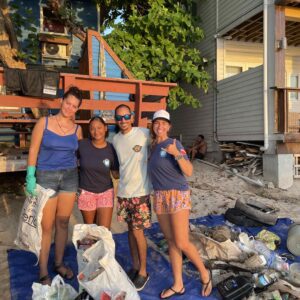
Team Sun Divers showing off their big pick up from a PADI Aware Week Dive Against Debris
From the beginning, we’ve been committed to making conservation a seamless part of the diving experience. Through the PADI AWARE Adopt the Blue program, we’ve officially adopted Candela’s Zen, a dive site that is sponsored by one of our customers through the Roatan Marine Park Name-A-Dive-Site program. While we’re very fortunate that trash pollution does not impact the majority of dive sites in Roatan, Candela’s Zen is a beautiful site that unfortunately finds itself in the path of runoff from local communities and currents that carry waste from other countries.
We conduct routine Dives Against Debris at the site and make that a focal point of how we celebrate Blue Friday, MesoAmerican Reef Day and Earth Day.
Every month you can also catch a Half Moon Beach & Bay cleanup. Volunteers help remove trash pollution from the beach, and also conduct snorkels against debris in the bay. Our partners (and neighbors) Sundowners Beach Bar & Grill award all volunteers with happy hour pricing all night. So, once the work is done, it’s off to watch the sunset with your toes in the sand and a happy hour cocktail in hand.
Get involved in Conservation in Roatan
Here’s a few other ways we’re staying eco-active in our community and how you can get involved:
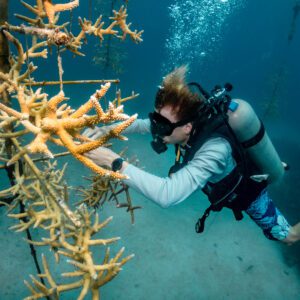
A diver cleans the RMP Coral Nursery as part of the Coral Ambassador program training.
Coral Restoration: Healthy reefs are vital to marine ecosystems which is why we love training divers to help to grow and transplant resilient coral species through the Roatan Marine Park Coral Ambassador certification. Our divers get hands-on experience assisting with these restoration projects, giving them a deeper connection to the reef and its recovery. Become a RMP Coral Ambassador!
Coral Spawning Monitoring: Coral spawning is one of nature’s most magical events, and monitoring it is crucial for understanding reef health. Sun Divers donates boats, captain time and volunteer time to collect valuable data on coral reproduction cycles, as well as to assist in sexual coral restoration efforts. Join the next Roatan Marine Park Coral Spawn Watch!
Petrochemical Sunscreen Ban: Sunscreen chemicals like oxybenzone and octinoxate are harmful to coral reefs, contributing to bleaching and reef degradation. That’s why we helped found the EcoSafe Sunscreen Coalition, an advocacy group working to make Roatan a petrochemical sunscreen-free destination. Sign the petition to help our efforts!
Sustainability as a Core Value
Becoming a PADI Eco Center isn’t just about conservation—it’s also about sustainability. We’ve taken steps to reduce our environmental footprint by:
- Eliminating paper waste with digital forms
- Using Stream2Sea reef-safe defog and shampoo/bodywash in our facilities
- Designating our dive center as a Petrochemical Sunscreen Free Zone.
Our dive shop operations minimize waste and energy use where possible. We also love partnering with businesses that share our values.
Every year, we conduct a sustainability self-audit through GreenFins, an internationally recognized initiative that promotes sustainable diving practices. This helps us assess our environmental impact and identify areas for improvement. By following GreenFins’ guidelines, we ensure that our operations align with best practices in eco-friendly dive tourism. Our commitment to GreenFins standards reinforces our dedication to responsible diving and continuous improvement in sustainability.
What’s Next for Sun Divers as a PADI Eco Center
Earning the PADI Eco Center designation is just the beginning. We’re constantly looking for ways to innovate and expand our conservation efforts. From hosting more citizen science projects to pioneering sustainable dive tourism practices, we’re excited to lead by example. Furthermore, we hope we inspire others to do the same.
While a dive shop may not be an NGO, it can absolutely be a force for good. At Sun Divers, we’re proving that diving and conservation go hand in hand. And we invite every diver to join us in making waves of change. Contact us for more information on how you can add impact to your next dive trip!
Let’s Talk Trash! 3 Ways to Reduce Waste Before it Hits the Ocean
As scuba divers, one of the most disheartening moments we can experience under the sea is having something shiny catch our eye only to discover it’s a piece of garbage. In Roatan, the majority of dives sites are relatively litter free. However, debris still makes its way onto pockets of our reef — mostly brought in from other countries by currents.
For many, the trash pollution problem can be “out of sight, out of mind”. This is especially true if you don’t live near the ocean. But the trash we stumble upon diving, is a dirty little reminder that the waste we produce at home – even hundreds of miles away – can still make its way into precious waterways.
And it’s not just about plastic. While plastic is a major contributor, textiles and electronics are also major sources of waste that finds its way onto the reef.
The good news is that you can be a part of the solution and it doesn’t even require major lifestyle changes.
Trying to figure out how to reduce waste before it reaches the ocean? Here’s 3 easy ways:
#1. Avoid Single-Use Plastics
It’s no secret that single-use plastics are a big problem. According to a PADI Aware Study conducted in 2018, single use plastics accounted for 33% of all marine debris. One of the easiest things we can to do reduce waste, is minimize our consumption of single use plastics.
From food packaging to grocery bags, bottled water, straws and plastic cutlery, single use plastics break down over time becoming microplastics.
Microplastics are then ingested by ALL living creatures. Even YOUR body is being polluted by microplastics.
Just as alarming is the fact that recycling isn’t the answer to the plastic problem that we’ve been trained as consumers to believe it is. Want to learn more about the scary truth about recycling plastics? Check out this eye-opening article to further understand why plastic reduction is a better approach than recycling.
We know: it’s not realistic these days to shun single use plastic entirely. So here’s a few ways to reduce your reliance on it:
- Use a reusable water bottle. We love Hydroflasks that keep liquids cool or warm.
- Refuse plastic straws and cutlery at restaurants. Make sure to make this request when ordering take out as well.
- Avoid MicroBeads which are also considered to be microplastics. They are tiny plastic particles found in many personal care items such as face wash, toothpaste, and cosmetics. They are marketed as “exfoliants” but the reality is, they get washed down the drain and end up as waste. Micro-beads are also used as bulking agents in products such as detergents, to extend the shelf-life of a variety of cosmetics, and to control the release of active ingredients. You can also visit https://www.beatthemicrobead.org/ to learn more about what products contain microbeads and how to avoid them
- Buy in Bulk: If you live in North America, you likely have access to supermarkets that sell items in bulk. Buying in bulk means you end up with significantly less packaging waste. It typically saves you some money as well! Even Amazon offers to package your order together in order to reduce packaging waste. Read more about their initiative here https://sustainability.aboutamazon.com/waste/packaging Less packaging means less production and transportation of those packaging materials, which helps to make a smaller environmental impact.
Buying in bulk isn’t limited to consumable items at the grocery store. Buying a 3-pack or 5-pack of t-shirts, underwear or any other clothing item is great for the environment too.
#2. Slow down on fast fashion
So many of us express ourselves through our style: the clothes we wear, the way we style our hair, how we accessorize. And fast fashion retailers have made it easier and cheaper to continuously reinvent ourselves and our look, season after season.
According to the UN Alliance for Sustainable Fashion, textiles alone account for 9% of annual microplastic losses to the ocean. Not to mention, the industry accounts for 10% of global carbon emissions.
If you want to feel good about looking good, here’s how to reduce waste coming from your closet:
- Go for style, not trends:Invest in clothing and accessories that stand the test of time—both in quality and design. Timeless pieces never go out of fashion, allowing you to build a wardrobe that remains stylish season after season.
- Give secondhand clothing a second life: Shopping for secondhand clothing is like spotting a stylish outfit on someone and getting the chance to make it your own. Whether you’re browsing local thrift shops like Goodwill, curated consignment stores such as Buffalo Exchange, or vintage boutiques, secondhand shopping allows you to discover high-quality, one-of-a-kind fashion at a fraction of the price. And now, with the rise of online resale platforms, sustainable shopping is more accessible than ever. Websites like ThredUp, Poshmark, and Depop offer a vast selection of pre-loved clothing from top brands, making it easy to refresh your wardrobe while reducing textile waste.
- Host a Clothing Swap: Living on an island like Roatan means limited fashion options—whether new or secondhand. That’s why we’ve learned here that one of the best ways to refresh your wardrobe is by hosting a clothing swap. It’s a fun, sustainable, and social way to breathe new life into pre-loved pieces. And you don’t even have to spend a dime.
The concept is simple: gather a group of friends, have everyone clean out their closets, and bring gently used clothing, shoes, and even household items they no longer need. Then, let the swapping begin! It’s like shopping in your best friends’ wardrobes, but without the price tag.Beyond the thrill of scoring new-to-you fashion, the real magic of a clothing swap is seeing someone fall in love with a piece you once cherished. It’s a reminder that style is cyclical, and clothing can have many lives. Plus, it’s an eco-friendly way to reduce waste.
Add some music, snacks, and maybe a fashion show, and you’ve got yourself a stylish, sustainable gathering that’s as good for your closet as it is for the planet!
#3. Buy Mindfully to Reduce Waste
The dopamine hit is real when it comes to online shopping. The instant gratification that we get with hitting the ‘Buy Now’ button or being able to immediately purchase something we see in a GRWM (get ready with me) reel can be downright addicting. But even if you don’t consider yourself a shopaholic, chances are that brand marketing tactics are filling up your online cart more than you realize.
This digital phenomenon has led to not only a wild surge in the purchase of plastic, textile and other goods, but also in the number of product returns. You might think you’re being a responsible consumer by returning a product to go back on the shelf, but the sad truth is that most returned goods go straight to the landfill.
Curious about the ways brands entice you to buy more and where all those returns end up? Check out Buy Now: The Shopping Conspiracy streaming on Netflix.
Want to consume more mindfully? Find ways to use the old PADI saying “Stop. Think. Act.” before you buy so you can not only reduce waste, but save money for that next dive trip!
- Remove 1-Click Buying Features: If your favorite online retailer has a 1-click button that allows you to purchase items without reviewing your cart – remove that feature. Here’s how to remove one click on Amazon. Just by eliminating this feature you’ll significantly reduce impulse purchases.
- Don’t store your credit card information. Removing your credit card information from “auto fill” options in your phone or on your web browser is another easy way to create a pause before purchase. Trust us, if you have to get up from the couch to go find your credit card, you’re definitely going to think twice about whether the purchase is worth it!
Take further action against marine debris and plastic pollution
You can join one of monthly beach cleanups or PADI Dives Against Debris at our Adopt the Blue site: Candela’s Zen.
There are also a number of charities that are actively working to combat plastic pollution by focusing on reducing plastic waste through cleanup efforts, advocacy, research, and education initiatives.
Not sure which one to choose? Here are a few of our faves:
The Ocean Cleanup:
Primarily focused on developing technologies to remove large quantities of plastic from the ocean, particularly in the Great Pacific Garbage Patch.
Ocean Conservancy:
Conducts beach cleanups, advocates for policy changes, and raises awareness about marine plastic pollution.
5 Gyres Institute:
Conducts research on plastic pollution in oceans, rivers, and streams, highlighting the scale of the problem.
Plastic Pollution Coalition:
Works on advocacy and communication strategies to promote solutions for plastic pollution.
World Wildlife Fund (WWF):
Advocates for global policy changes to reduce plastic pollution, including a legally binding treaty on plastic waste.
Most of the charities that we’ve highlighted have petitions that need signatures to pass and hold campaigns for positive change. Be sure to check back frequently with your favorites to see if there are more ways you can get involved and be a part of the change.
Ready to get started? You can help us ban petrochemical sunscreens, another major pollutant in Roatan from the comfort of your couch! Visit https://sundiversroatan.com/reef-safe-sunscreen-roatan/ to read about it and be sure to sign the petition.
7 Reasons Why Roatan is Great for Diving
If you’re searching for an unforgettable diving experience, look no further than Roatán. This tropical island offers many reasons for why it’s the perfect destination for divers seeking adventure, natural beauty, and marine biodiversity. Let’s explore the enchanting wonders that make Roatan great for diving.
1. World-Class Dive Sites in Roatan:
Roatan is a diver’s playground. As part of the Mesoamerican Barrier Reef, it has an abundance of dive sites to suit every preference and skil level. This makes Roatan great for diving! Whether you’re a new or an experienced diver, there’s a dive site that will leave you stunned. From vibrant coral reefs teeming with marine life, to jaw-dropping wall dives and intriguing shipwrecks. Each dive in Roatan promises a new and exciting underwater adventure.
Want to know which dive sites are our favorite? Check out our Top 10 Roatan Dive Sites list.
2. Endless diving opportunities year-round:
One of the remarkable features of Roatan is its year-round diving opportunities. Thanks to its great location the climate is very steady throughout the year. Roatán is great for diving at any time of the year. With warm temperatures and minimal rainfall through most of the year, you’ll experience excellent visibility and calm waters. This ensures an unforgettable diving experience whenever you choose to visit. If you’re interested in when the best time to come visit Roatan is, check out our blog post.
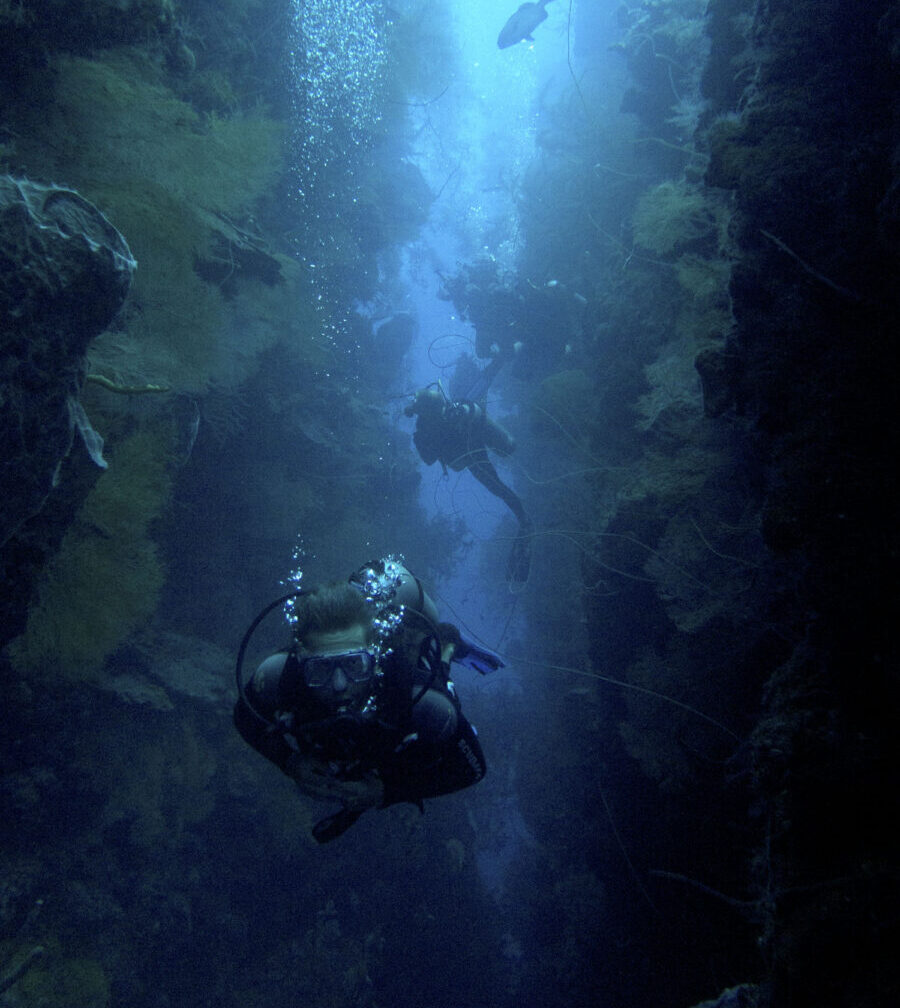
3. Easy access and short travel:
Getting to dive sites in Roatan is a breeze. Sun Divers is located right at the doorstep of many of our favorite dive sites. So, it’s often just a few minutes by boat. Short boat rides mean less time commuting and more time exploring the captivating underwater world. We offer two tank morning dives and afternoon explorations. If you’re up for an adventure we can also full-heartedly recommend our night dives. Thanks to the short commute you’ll still make it back on time for a nice dinner afterwards. See our favorite places to eat!
4. Ideal for learning:
Roatan is the best place to get scuba certified. The year-round calm and clear waters of Roatan create a comfortable and welcoming environment. This means you focus on learning to scuba dive or advancing your skills without also trying to navigate tricky dive conditions. Roatan is an ideal destination for beginners and those looking to expand their diving proficiency. You can sign up for any of our courses any time of the year. Check out the courses available at Sun Divers and get your PADI in Roatan! At Sun Divers, you’ll find a team of experienced staff and instructors from diverse backgrounds. We are ready to guide and support you on your diving journey
5. An abundance of marine biodiversity:
Roatan is a haven for marine life enthusiasts. As soon as you’re beneath the surface, you’ll be greeted by an awe-inspiring world of biodiversity. Encounter majestic eagle rays gracefully soaring through the water. Catch a glimpse of sea turtles gracefully gliding by. And witness a great variety of colorful tropical fish species in their natural habitat. Into the smaller stuff? You can also find an array of macro life from millimeter size nudibranchs to interesting small shrimp and crab species. Roatan’s rich ecosystem is truly a treasure of marine wonders waiting to be explored.
6. A protected marine park:
One of the reasons why Roatan is great for diving and has such breathtaking marine biodiversity is its conservation efforts. The island is surrounded by a protected marine park. At Sun Divers, being ‘always eco-active’ is a core value and we’re proud to sponsor the Roatan Marine Park, as well as donate the use of our boats and employee volunteer time for coral restoration activities. We actively promote and practice sustainable diving. Emphasizing respect for marine life and habitats is imperative to us and we require all of our divers to support the annual Roatan Marine Park access fee ($10) which goes toward the protection of the park. By choosing to dive with Sun Divers, you contribute to the preservation and protection of Roatan’s fragile marine ecosystem, ensuring its beauty can be enjoyed for generations to come. We share this passion and dedication with our dive community and offer a Coral Ambassador course in which you can learn to help with coral restoration.
7. More than just diving!
Roatan isn’t just a diver’s paradise. It also offers a great hotel and restaurant scene that adds to the island’s appeal. After a day of diving and exploring the underwater wonders you can treat yourself to a culinary adventure on land. Roatan boasts a range of dining options that cater to various tastes and preferences. Charming seaside seafood shacks are serving up the freshest catch of the day. And upscale restaurants offer international cuisine. There’s something to satisfy every taste.
Discover our 10 Top Restaurant Recommendations While in Roatan!
What are you waiting for?
Roatan is great for diving – That is undeniable! This island embodies everything and more that you wish for when diving. Embark on an unforgettable journey with Sun Divers and immerse yourself in the magic of Roatan’s underwater realm. Let the island’s natural beauty and captivating marine encounters leave its mark on you. Roatan is great for diving. Come discover its hidden treasures with us. Contact us so that we can put together en epic dive trip itinerary for you!
Do You Need a Wetsuit to Dive in Roatan?
Roatan is a Caribbean paradise known for its scenic and beautiful reefs. Its warm tropical waters attract a diversity of marine life and many divers each year. But are Roatan’s waters so warm that you don’t need a wetsuit to dive in Roatan?
Generally, yes, most people need a wetsuit to dive in Roatan. But depending upon the year and personal preference, the type of exposure suit you need can vary from full 3mm to even just a rashguard.
Let’s explore the 5 factors that can help you decide if you need a wetsuit to dive in Roatan and what type of wetsuit is best for you:
1. Water temperature
While Roatan enjoys cozy tropical waters throughout the year, the temperature can vary slightly depending on the season. The average water temperature ranges from 80°F (25°C) to 84°F (29°C). The water tends to be warmer during the summer months from May to September. The temperature slightly drops during the winter months from October to April. If you’re on the “get-cold easy” side or plan to do multiple dives a day, a wetsuit can provide added comfort and insulation.
Most divers choose to wear a 2.5mm shorty or even just a rash guard and leggings during the summer months. And then a full 3mm wetsuit during the winter months. People who get colder might also opt to add an extra layer of protection with a hooded vest under their wetsuit to dive in Roatan. Then there are those who seem to run hot year-round and opt for just a shorty or rash guard any time of year. This gives them ultimate freedom and mobility – but isn’t for the faint of heart!
If you want to find out more about the weather in Roatan throughout the year, read our post on: When is the best time to dive in Roatan?
2. Dive duration
The longer you’re in the water, the colder you might get. For short dives in shallow water, you’ll maybe be comfortable enough without a wetsuit. But for longer dives a wetsuit can help regulate your body temperature and protect you from potential heat loss. It’s really annoying to not enjoy your dive because you’re too cold. You might also get cold, when you’re doing multiple dives a day. At Sun Divers, all fun dives are at least 60 minutes. Consider how long your dives and surface intervals will be for your decision on if you need a wetsuit to dive in Roatan or not.
3. Dive depth
Another factor to consider when deciding whether you want to wear a wetsuit to dive in Roatan is your dive depth. As you descend into deeper waters, the temperature drops. In Roatan, the water temperature starts to cool when you descend beyond approximately 30 to 40 ft (9 to 12 m). You might feel the temperature drop a bit, especially if you spend an extended amount of time down there. If you’re into deep dives, Roatan has a few interesting dives that you might want to check out such as Hole in the Wall and our wrecks, The Aguila and Odyssey. It is important to note that the exact temperature variation can vary depending on factors such as the season and current as well.
In order to dive below 60 ft (18m) you need to be Advanced Open Water certified or do it as an Adventure Dive. You can find out about the benefits to get Advanced Open Water certified in our blog post.
4. Personal comfort
Every diver has their own preferences and comfort levels when it comes to ideal water temperatures. Some divers may feel comfortable diving without a wetsuit in Roatan’s warm waters. Others may prefer the added comfort, protection and warmth that a wetsuit provides. Ultimately, it is a personal choice based on your individual comfort and needs. Regardless of your decision, we always recommend wearing a rash guard or mineral-based sunscreen to protect your skin from the sun’s rays. If you do wear sunscreen please avoid petro-chemical sunscreens.
You can find out more about reef safe sunscreen.
5. Protection
Besides temperature regulation, wetsuits also offer additional benefits such as protection against the sun’s harmful rays or jellyfish stings. Diving in tropical environments closer to the equator means being exposed to intense sunlight, and wearing a wetsuit can provide a layer of UV protection for your skin. Luckily, we don’t see many jellyfish in Roatán. But occasionally, they hang out at the surface during night dives. If there is any, a wetsuit will protect you from being stung.
Gloves are not allowed
Did you know that in the Roatan Marine Park, the use of gloves during diving is not permitted? There are good reasons for this regulation. The main purpose of the Roatan Marine Park is to protect and preserve the delicate marine ecosystem of this incredible reef. This includes the corals and other marine life. Gloves can unintentionally cause damage. The texture of gloves can damage corals and other fragile organisms when touched. Gloves may also give divers a false sense of security. This can lead to careless contact with delicate structures. Eco friendly and sustainable diving practices are a top priority at Sun Divers. By respecting the “no gloves” policy, we can contribute to the conservation efforts of the marine park and ensure that no one is “touching, taking or teasing” the wildlife.
We’ll help you choose
At Sun Divers, we understand that divers have different preferences when it comes to thermal protection and sun exposure. Our experienced staff will guide you and give you recommendations based on current water conditions, your individual preferences, and the dive site characteristics. We offer a variety of different style and thickness wetsuits to rent from including 3mm full wetsuits, shorties and a variety of rash guards.
If you prefer to purchase your own wetsuit we are a certified Scubapro dealer and we offer deals, as well as direct shipping to Sun Divers customers.
Whether you choose to dive with a wetsuit, a rash guard, or without any additional protection at all, discover the beauty of our underwater world and embark on unforgettable diving adventures in Roatán with Sun Divers. We prioritize safety, small group diving and epic adventures.
So, do you need a wetsuit to dive in Roatán? The choice is yours, and we’re here to support you every step of the way as you explore the wonders beneath the surface of the Caribbean Sea. Contact us for more information.
How to Choose From the Best Dive Shops in Roatan
Dive Shops in Roatan are like Starbucks cafes in the U.S.: there’s one on every corner!
Just google ‘best dive shops in Roatan’ and over 50 different Roatan dive centers pop up. Some are boutique operations and others are all-inclusive. Some boast large boats for big groups and others focus on smaller, more personalized experiences. With all the choices, what’s a diver to do? If you’re finding it difficult to decide which Roatan dive shop to entrust your dive vacation to, evaluate your options using this guide on How to Choose from the Best Dive Shops in Roatan.
Full disclosure, this guide was created by Sun Divers Roatan. Why? Because while we’d love for everyone to dive with us, we know that our island is a world-class diving destination with many reputable Roatan dive centers to choose from. While there’s a dive center for everyone, not all dive centers are created equal. And what makes a great dive center to you might be different for another diver. So we’re presenting this guide to help you find the best dive shop in Roatan for YOU!
Here are 5 criteria to help you choose from the best dive shops in Roatan. You can also use this criteria to assess dive centers in any dive destination!
5 Criteria to Choose from the Best Dive Shops in Roatan
1. Location, Location, Location
Location is a top consideration when deciding which of the best dive shops in Roatan is just right for you. Roatan is made up of several villages and the most popular destinations for divers include West End, West Bay, Sandy Bay and Camp Bay. Each ‘village’ (or neighborhood) has its own character and vibe, as well as natural beauty and local amenities. You can find options for great Roatan dive shops in all these areas. Here’s a few ways to assess location:
Proximity to Popular Dive Sites: Roatan has a fringing reef with literally hundreds of moored dive sites surrounding the island.
The Northside of the island is sheltered from the prevailing winds, creating ideal dive conditions almost year-round. So, most of the popular dive sites are located on this side of the island – particularly in the northwest where West End Village and West Bay Beach are located. In West End, Roatan dive shops are going to be more centrally located to the majority of dive sites on the Northside. West Bay, Roatan dive shops and Sandy Bay dive shops will be closer to their respective areas.
However, the most popular dive site in Roatan, Mary’s Place, is ironically located on the Southside of the island. It is exposed to the easterly winds and thus typically has more waves and surface current. The topography of the reef and marine life on the Southside can also differ. This side of the island tends to have more dramatic deep walls and swaying soft corals. While the Northside is known for its extensive plateau with exciting swim throughs and channels carved through it. Some dive centers, including Sun Divers, travel to the Southside when we have either perfectly flat seas or northern winds make the conditions more ideal on this side. Read about ‘Southside Days’ here.
If Mary’s Place Roatan is on your bucket list and your dive shop can’t take you there, you can always do a day of diving with Barefoot Cay. This Roatan dive resort is located right by the dive site and also has an amazing poolside restaurant to spend the rest of the day.
Close to the action (or not!): Depending upon your vacation style, you’ll want to find a dive center (and lodging) that is in a Roatan village with the right vibe for you.
West End village might just be your vibe if you like to travel more like a local but still have access to great cuisine and entertainment. Akin to a sleepy beach town with character, West End has a few boutique hotels and tons more vacation rentals. You can walk to lots of great beach front restaurants – many featuring live music and other special events throughout the week.
If an all-inclusive Roatan dive resort with beautiful beach views is more your style, West Bay will be for you. The waters are turquoise, the sands white and the beach is bustling! Most hotels have an affiliated dive center on site for convenience. Forewarning, this area is a hot spot for large groups of cruise shippers and the beach can be crowded with both visitors and vendors.
If you want to feel more remote, but still within a quick jaunt to the happening spots, then you might consider Sandy Bay. This is a primarily residential neighborhood along the beach with a few vacation rentals and lodges with small dive shops. There are also a few local restaurants, but most of the lodges also have fantastic dining spots on site. You will likely need a rental car or a hired driver for most activities and to access the best beaches and restaurants.
And if you really want to get off the beaten path, look to Roatan’s East End. Here you’ll find eco resorts and undeveloped beaches for a more organic and rustic feel to your vacation.
Sun Divers is located in West End Village, Roatan on the shore of Half Moon Bay. We’re smack dab in the middle of over 70 different dive sites on the Northside and make it a point to take you to as many different dive sites as possible. When conditions allow, we will head out to explore more remote locations like Mary’s Place on the Southside, Roatan’s East End dive sites more remote locations like the seamounts and Cayos Cochinos. We’re neighbors with the iconic beach bar Sundowners and the Beach House boutique hotel, with whom we have a Dive & Stay packages available May through November. This little corner of West End is a real chill vibe and you could never leave. But if you do want to explore the best restaurants and bars – we’re just a beachy stroll away.
2. Dive Group Organization
Save yourself from frustrating dives by asking the Roatan dive centers that you’re assessing how they organize their fun dive groups.
Be sure to find out about the group sizes and number of people per boat when doing your research. Specifically, ask what the diver to divemaster ratio is for fun dives. Obviously the less fun divers assigned to a divemaster, the less likely you are to have to wait your turn to see cool stuff. And the less likey you’ll find fins in your face!
How the groups are organized matters as well. Find out if groups are arranged by skill level. If you’re into photography, see if there’s an opportunity to dive with other photographers or to even organize a photography dive.
If you are a student yourself, ask about the course ratio. While some PADI courses allow for up to 8 students per instructor – we believe that courses are more manageable for instructors and students get more personal attention when the ratio is 4 students to instructor or less.
When it comes to group size, we believe less is more! Our fun dive groups are kept relatively small at no more than 6 divers per guide. We organize groups by skill level and interest whenever we can, and also keep track of where everyone dives so that we can make sure you see a wide variety of Roatan diving. Courses are capped at 4 students per instructor to allow for more personalized attention even in a group setting.
3. The Type of Roatan Dive Center
There are many different types of dive shops in Roatan. Each offer a different environment (or “vibe”) and customer service experience. Each also has different amenities and course offerings. Here are a few examples of the type of dive shops in Roatan you can find:
- Boutique Dive Centers: These are smaller operations that focus mostly on recreational diving and courses. The boats are smaller with a capacity of around 10 people compared to 20+. Many offer 3-4 dives per day and cater to a personalized experience. These centers cater to folks who are visiting Roatan with the primary focus to dive and explore as much as they can. You’ll get a mix of experienced and well-traveled divers, along with younger people who have a newfound passion for scuba diving. The most popular boutique West End dive shops include Sun Divers and Roatan Divers.
- Dive Resorts: These centers are usually connected to hotels. Dive resorts are most prevalent in West Bay and tend to cater toward large groups and families. Many offer all-inclusive deals and also have amenities in common with the hotels they’re located within such as a pool, restaurants, gym and beach lounge chair access. Most of the Roatan dive resorts are located on West Bay beach. Some of the all inclusive resorts there include Mayan Divers and Infinity Divers. In Sandy Bay, you’ll find Anthony’s Key resort – the first dive resort on the island. And on the southside of the island, Coco View which is also one of the longest standing resorts and caters to underwater photographers.
- Instructor Development Centers: These operations offer recreational diving, but also focus heavily on training programs for divemasters and instructors. These centers will have a youthful, international vibe with young people who come from around the world to become dive professionals. On the boat, you will usually find a mix of fun dive groups with students who are doing their professional training. Many of our divemasters move on to become instructors with Go Pro Caribbean.
- TEC Centers: Similar to dive pro training centers, TEC centers offer niche instruction in technical diving. The centers that offer technical dive training in Roatan, also offer recreational diving, as well as professional training. Roatan Tec Center is one of the longest standing TDI certification centers on Roatan.
Sun Divers is a boutique dive center focused on curating epic dive trips for recreational divers. No one’s feeling like a number here. We take great care to pair you with divers of similar skills & interest, and make sure to show you a wide variety of dive sites. No heavy lifting required here! We set up your gear for your on the boats and will store all of your personal gear for you securely for the duration of your dive trip.
If you’re a student, you’ll learn from one of our experienced PADI scuba diving instructors and we always keep our groups small to ensure plenty of personal attention.
4. Quality of Gear and Boats
Don’t be afraid to ask questions about the type of gear stocked by the dive shops that you’re considering. Here are some questions to consider asking:
- What is the brand/model of the BCDs, regulators and wetsuits?
- When was your equipment last replaced?
- Do you use weight integrated BCDs or weight belts?
- How often do you conduct hydrostatic testing and visual inspections on your tanks? Hydrostatic requirements can be different based upon region, but typically should be conducted every 5 years. Visual inspections should be conducted annually. impeccable
At Sun Divers, we have a strict commitment to quality, whether it’s our all-star team, our impeccable boats and facilities, or the top-rated SCUBAPRO rental equipment we offer. Check out the details on our BCDs, regulators, fins, wetsuits and masks available for rent. And take a look at our custom dive boats built for comfort and speed.
5. Environmental & Social Responsibility
As beautiful as coastal communities like Roatan are, they face a number of unique environmental and socioeconomic challenges. While tourism and scuba diving are economic growth engines for our island, they do also contribute to increased pollution and pressure on our reefs. And as coastal communities have moved away from harmful commercial overfishing, that workforce has had to find new ways to make a living.
That is why it’s important to find a Roatan dive center that conducts its operations in an environmentally friendly way, as well as supports local conservation efforts.
A few considerations:
- Is the Roatan dive center you’re assessing a supporter of the Roatan Marine Park either as a sponsor or Coral Restoration center?
- Do they support any other local conservation efforts or local nonprofits?
- Do they promote eco-friendly diving guidelines on their website?
- Do they have a sustainability program?
We’re on a mission to not only be the best dive shop in Roatan, but to also make the biggest difference. We are sponsors of the Roatan Marine Park, as well as a RMP Coral Restoration center. We’re proud supporters of the Bay Island Conservation Association and we also run our own scuba scholarship program for island girls in partnership with Roatan Peer Health Exchange and PADI. We also host the island’s premier Charity Golf Tournament event which raises money for the SOL Foundation and has earned us the prestige of hanging the Golden Buoy in our dive shop!
Other Considerations for Choosing the Best Dive Shop in Roatan for You:
- What do other customers say about them? Check out TripAdvisor and Google Reviews.
- How quickly do they respond to your inquiry?
- How thorough is the information they provide?
- Do they offer multi-dive packages? When it comes to dive services, you get what you pay for. So while cheaper doesn’t equal better, it
- Do they offer any unique experiences such as trips to Mary’s Place, Cayos Cochinos or other remote areas?
Check out what our divers have to say about us on TripAdvisor! If we sound like the best dive shop in Roatan for you, shoot us an email and let’s start planning the most epic Roatan dive vacation ever!
5 Reasons to Get PADI Advanced Open Water Certified
Are you weighing the cost vs. benefit of getting your PADI Advanced Open Water certification? If so, you’re not alone. When you become open water certified, you’re technically able to do any recreational dive. So you might be thinking ‘why get my advanced?’
But we promise, you learn and experience something new with the PADI Advanced Open Water certification – whether you’re a new open water diver or have been exploring depths for decades. And the more training you have, the safer a diver you’ll be, which is never a bad thing. Plus, the course is only two days, requires minimal self study time and is just plain fun to do.
Not convinced yet? Here’s a few good reasons that we think will convince you to get your PADI Advanced Open Water. And hopefully you’ll do it in Roatan!
1. Elevate your expertise
Whether you’re still new to diving or already have hundreds of dives logged, the PADI Advanced Open Water course presents the perfect opportunity to build upon the fundamental skills you have acquired. It enables you to expand your knowledge of dive theory and skills proficiency, so that you’re well-equipped for the challenges and wonders that lie beneath the surface.
The PADI Advanced Open Water certification is fun and flexible, and it takes a more hands-on approach to learning. You learn by diving: No written exams required! Instead, you have informative briefings before and after each dive, and you practice achieving dive objectives and safety protocols.
You can gain a deeper understanding of how to control your buoyancy with your breath in the Peak Performance Buoyancy adventure dive. Or you can learn the proper way to signal and communicate with your dive buddy during night dives. When you immerse yourself in these real diving scenarios, you gain hands-on experience and practical knowledge that deepens your expertise.
2. Gain access to advanced dive sites
If you dive with a reputable dive shop, they will only take you to your training limits. This is especially true when it comes to advanced deep dives, night dives or wreck penetration. Without your advanced certification, reputable dive shops in Roatán won’t take you to see our majestic wrecks at 100 feet or on a night dive to see the String of Pearls.
As an open water diver, you can dive to 60ft/18. When you get PADI Advanced Open Water certified, you are trained to dive to 100ft/30m. Roatán deep dives include wrecks such as El Aguila and the Odyssey shipwreck, as well as an amazing swimthrough experience at Hole in the Wall. These dives are also a great opportunity to develop your deep diving skills. And the Deep Adventure dive in the PADI advanced open water course counts toward the PADI Deep Diver Specialty.
There are also a few dive sites in Roatan that are worth diving on Nitrox. The Enriched Air specialty certification is offered at a discount when bundle it with the PADI Advanced Open Water course at Sun Divers. Check out the benefits of diving Nitrox.
The Open Water course teaches the fundamental skills and safety procedures of diving, but the PADI Advanced Open Water course focuses on expanding those skills and introduces divers to new dive environments and scenarios. Divers complete 5 adventure dives. Each dive focuses on a specific type of diving or skill. The best part: You can get Advanced Open Water certified in Roatán in only 2 days. While navigation and deep diving are mandatory adventure dives, you have the flexibility to explore 3 additional specialties such as:
- Night Diver
- Fish Identification
- Drift Diving
- Peak Performance Buoyancy
- Wreck Diving
- Underwater Naturalist
- Digital Underwater Photography
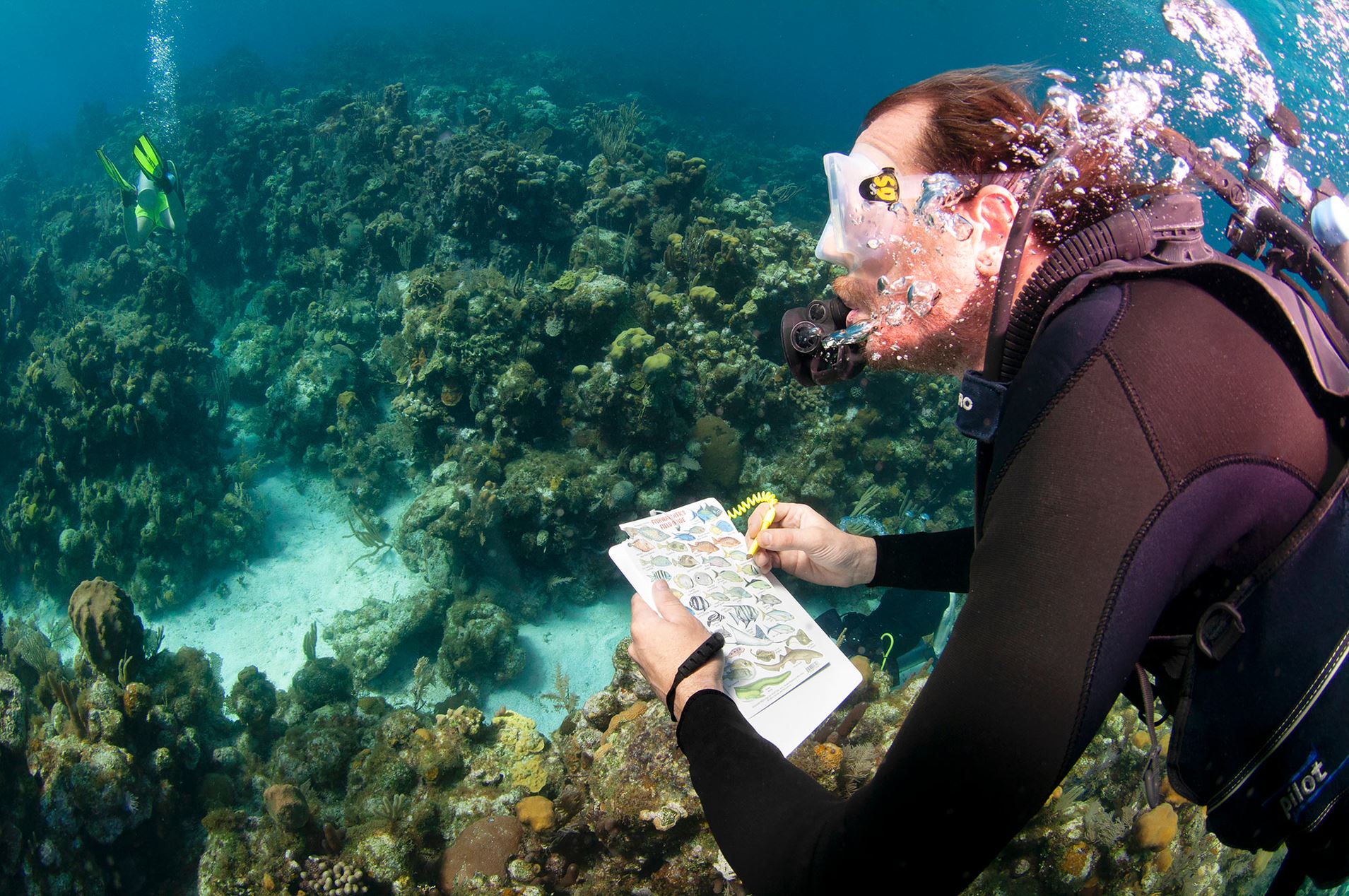
During the Fish Identification Adventure Dive you can learn how to properly identify various groups of fish in Caribbean waters and around the world.
3. Dive with more confidence
With each adventure dive, you gain remarkable growth in your confidence as a diver. By applying your skills in different dive scenarios, you develop the ability to adapt to a variety of conditions and environments. This newfound confidence will enable you to explore with a sense of ease and safety. You’ll know that you have the knowledge and training to handle different situations.
4. Make your dives more interesting
The skills you perform during the PADI Advanced Open Water course add an interesting new twist to diving. This makes it an entertaining course to take, especially if you feel like you’ve seen and done it all in diving or love a good mental challenge. You will try your hand at number games and math at depths to safely learn how nitrogen narcosis can affect decision making and motor skills. You’ll learn how to easily use a compass under water – and on land for that matter! And you can go through an underwater obstacle course to practice staying neutrally buoyant or learn underwater photography basics.
5. It’s required for other courses
The PADI Advanced Open Water is the first continuing education course you need this certification if you have any interest in other PADI courses. It’s a requisite for Rescue Diver and Divemaster. And you must be advanced certified or at least have your PADI Adventure cert in order to achieve most of the PADI specialty certifications. Luckily, the adventure dives also count toward one of the open water dive requirements for all the specialties – so you get some bang for your buck there!
Why Get Your PADI Advanced Open Water in Roatan?
With Roatán’s year-round diving opportunities, you can get certified at any time of the year. Immerse yourself in a wide variety of exhilarating dives, from deep sea swim throughs to intriguing shipwrecks. When you embark on your PADI Advanced Open Water certification journey with Sun Divers you’ll get to learn with a experienced and knowledgeable instructors from diverse backgrounds. You’oll enjoy the advantage of small course groups, ensuring personalized attention and a safe learning environment.
So, is it worth it to get your Advanced Open Water certification?
Whether you’re a recent Open Water certification holder or an experienced diver, the transition to become a PADI Advanced Open Water Diver offers an exciting opportunity to expand your expertise. It’s also a chance to connect more with the worldwide diving community. When you get PADI Advanced Open Water certified, you learn by diving. You will dive more confidently and be able to dive as deep as 100ft (30m). Embrace the thrill of real-world dive experiences, deepen your skills, and unlock your full dive potential.
Are you ready to embark on this extraordinary journey? Contact us to schedule your Advanced Open Water course in Roatan.
4 Types of Divers Who Should Be Diving Nitrox
Many recreational divers know of enriched air (nitrox), but aren’t familiar with it enough to know if they could benefit from diving nitrox.
The benefit of diving nitrox is that you absorb less nitrogen. So it’s safe to say that you should dive enriched air whenever you can. Why? Because with less nitrogen absorption you can enjoy a longer allowable bottom time and also improve your safety margin as it relates to decompression sickness (DCS), when diving on an air profile.
But there are certain types of divers who benefit more significantly from diving nitrox. We’ve identified the 5 Types of Divers who should dive enriched air. Read on to see if you’re one of them!
But first: Are you nitrox curious, but feel like you need a primer on what nitrox is before determining if you should be diving with enriched air? Check out details on nitrox and the PADI Enriched Air Diver course here.
4 Type of Divers Who Should Be Diving Nitrox
1. The ‘Dive All Day, Every Day Diver’
If your primary purpose for vacationing is diving, and your name is on every daily dive possible, then you might consider diving with enriched air – even if your group is following an air profile. Many divers who use it daily for typical-duration dives swear that they have more energy than if they were diving on air. While nitrox has not been proven to reduce fatigue, logically it makes sense since your body is absorbing less nitrogen and not having to off-gas as much.
2. The Liveaboard Junkie
Similarly, if you’re someone who loves liveaboards or is considering one – you definitely want your nitrox certification. Most liveaboards will offer nitrox for free or deeply discount. And that’s smart, because unlike dive centers who typically offer 3-4 dives a day, liveaboards can offer up to 5 dives per day – that’s a lot of residual nitrogen that can build up from dive to dive. A smart way to manage your safety margin on a liveaboard is to dive nitrox on the nitrox profile for the first 3 dives, and then dive nitrox on an air profile for the remaining 2 dives of the day.
3. The ‘Go Deep or Go Home’ Diver
If you get a thrill from deeper depths then nitrox will keep you from pushing your limits (no deco limits that is!). While you can’t necessarily dive deeper on nitrox. This means that you have more time to stay at those depths, assuming you have enough gas, and you’re less likely to “bump up” to your no deco limits when diving at a deeper range. Of course, you still have to be mindful of your the maximum operating depth on nitrox, as it will be shallower than the recreational depth limit we have when using air (40meters / 130 feet.)
4. The Super Safe Diver
If you’re the type of diver who never forgets a buddy check and gets peace of mind from conservative dive profiles, we applaud you and also recommend that you dive with enriched air. Diving nitrox can give you additional peace of mind on your dive, because it’s less likely for you to “push” your no deco limits. And when diving nitrox on an air profile, you can reduce your risk of DCS.
Age, Weight and Nitrox
Two other important factors to consider when choosing whether or not to dive nitrox are age and weight. While no one wants to admit they’re getting older or that they’ve put on a few extra pounds, neither of those factors have to stop you from diving. But the reality is that they can increase your risk of decompression sickness. Nitrogen is more easily absorbed in our fat tissues. And as we age our circulatory systems slow which also slows down the process of off-gassing nitrogen. So if these are factors for you, diving nitrox is a smart decision.
Know that we’ve shared the 4 types of divers we believe should be diving nitrox, and additional health factors that make it a good move, it’s your turn to decide if nitrox is right for you. Not certified to dive with enriched air? It’s a relatively quick and easy course, that is also very cost effective to do while diving in Roatan. Learn more about the PADI Enriched Air (Nitrox) Diver course at Sun Divers!
Can You Dive With Whale Sharks in Roatán?
Roatán is definitely a hidden gem of the Western Caribbean. And a true divers paradise. With its vibrant coral reefs, diverse marine life, and captivating underwater landscapes, it’s no wonder that divers love visiting this tropical island time after time. Whale sharks can be found on the bucket list of many divers. So you’re probably wondering: can you dive with whale sharks in Roatán? Many articles on the internet will tell you, yes. But in our experience, the answer isn’t quite so simple. So we are on the quest to uncover the truth about if you can dive with whale sharks in Roatán with the help of Gabriela Ochoa. She is a local marine biologist, who has recently founded the marine conservation nonprofit Ilili.
Does Roatán have whale sharks?
A frequently asked question by diving enthusiasts is, “Can I dive with whale sharks in Roatán?” While there have been rare sightings of these magnificent creatures near the island, encounters with whale sharks are exceptionally rare. Gabriela explains the chances of spotting a whale shark in Roatán are “once in a blue moon.” The Sea Lucas project, which has developed an interactive map for shark sighting in Roatán and the Bay Islands, reports only 2 reported whale shark sightings in Roatán since 2009. While numbers might be slightly higher due to lack of reporting, this is the most accurate source of data on Whale Sharks in Roatán. Utila, Roatán’s sister island, is considered a better spot for whale shark encounters – but even they have only had 7 reported sightings since 2009. The most common way for us to spot a whale shark is usually from the boat offshore. This means that encounters are very unpredictable and far out in the ocean. For this reason, most encounters end up being snorkel ones.
What is the best time of the year to see whale sharks?
Whale sharks are migratory creatures, traveling vast distances in the search of food and suitable breeding grounds. The presence in any given area is directly influenced by factors such as ocean currents, food availability and migration routes. Contrary to common belief, whale sharks are not vegetarian and feed on zooplankton as well. They have been observed to follow spawning aggregations of fish. Some bigger fish populations such as snappers are usually spawning during a certain season. Because of this, whale sharks are more frequently sighted between December to March around Roatán. Unfortunately, the depletion of fish populations in recent years has resulted in less frequent whale shark encounters in many places – including Roatán.
Diving responsibly with whale sharks in Roatán
While the desire to dive with whale sharks is understandable, it is vital to prioritize their natural patterns and habitats. As migratory species, these magnificent creatures require protection and conservation efforts to ensure their survival and to avoid any disturbance that may disrupt their delicate ecosystem. Unfortunately, many sites around the world that specifically promote whale shark diving might end up overwhelming and leaving these shy giants feeling stressed. At Sun Divers, we believe in practicing responsible and sustainable diving. If there ever is a whale shark sighting in Roatán, you can be sure we will approach it with utmost care and respect.
Unveiling Roatán’s marine treasures
It is not commmon to see whale sharks while diving in Roatán, but the island still offers an array of other captivating marine life encounters. As you explore Roatán reef sites, be prepared to experience a breathtaking variety of wildlife. In Roatán, divers are lucky to frequently encounter turtles, rays, and even some large marine mammals such as dolphins and pilot whales. There is rarely a ‘Turtle Tuesday’ in Roatán where a turtle isn’t showing its face. Of course, there is always an element of surprise and we can never guarantee the sight of specific wildlife while diving.
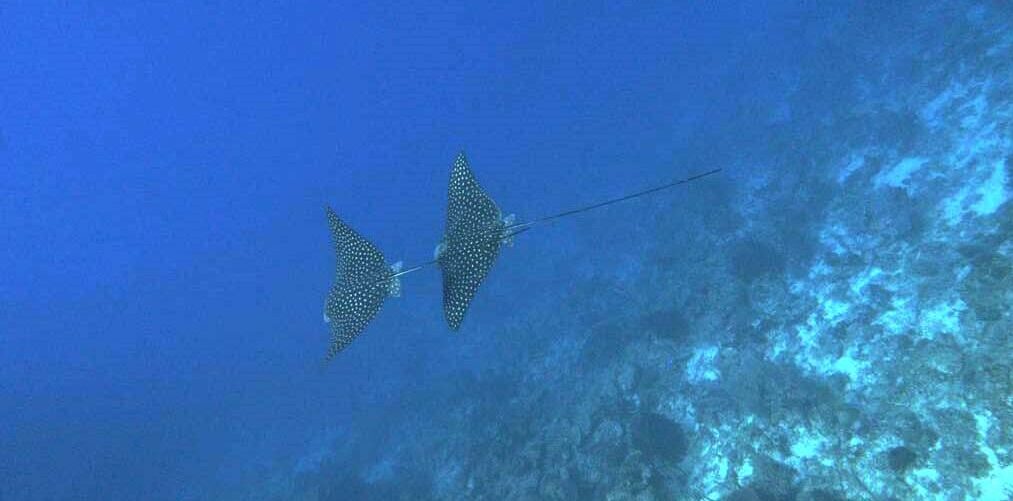
Two eagle rays are soaring through the waters in Roatán, Honduras.
Contribute to marine conservation while diving in Roatán
Eagle rays are among the stars of Roatán’s underwater world. These magnificent creatures, with their expansive wings and mesmerizing patterns, leave divers spellbound. Spotting an eagle ray gracefully gliding through crystal-clear waters is an experience that will be engrained in your memory forever. Monitoring and mapping of marine animals such as eagle rays and sharks is an important aspect of conservation. For this reason, it is helpful if you take pictures and report your sightings. “There is a lot of power in citizen science. Just contributing a picture can go a long way and has a great positive impact,” Gabriela said. Check out our guide on how to help with conservation.
Looking for a cool way to contribute to conservation while diving? Consider our RMP Coral Ambassador program!
In short – Are there whale sharks in Roatán?
While the chances of diving with whale sharks in Roatán may be rare, this marine paradise offers an abundance of incredible wildlife experiences. Keep an open mind and embrace the underwater wonders that await you. From elegant eagle rays to the vivid diversity of coral reefs, every dive is an opportunity to connect with the ocean’s beauty and contribute to its conservation. By practicing responsible diving, supporting local conservation programs, and spreading awareness about the fragility of marine ecosystems, we can together help protect Roatán’s natural heritage for years to come.



